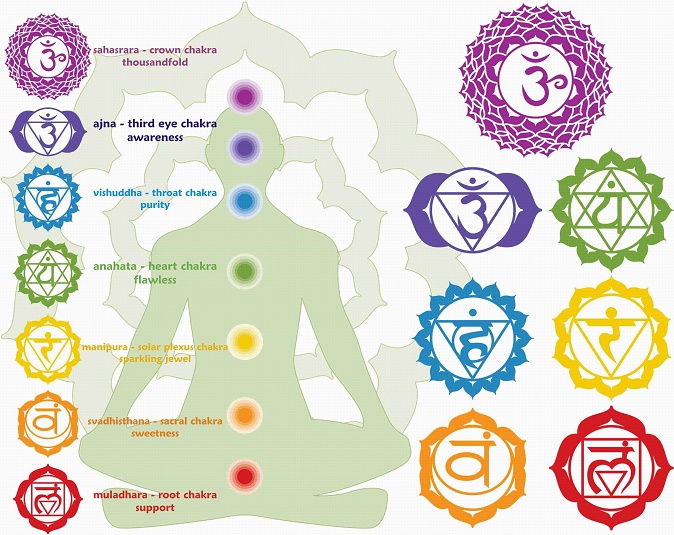Our bodies are more than just physical beings; they are intricate energy systems with powerful centers that influence every aspect of our lives. These energy centers, known as chakras, are deeply embedded in ancient Indian wisdom and form the foundation of spiritual and physical well-being. From the base of the spine to the crown of the head, each of the 7 main chakras plays a unique role in regulating our emotional, mental, and physical health. In this post, we’ll take a journey through the seven chakras, exploring their functions, signs of imbalance, and ways to activate and heal them. Whether you’re a beginner or someone well-versed in chakra work, understanding these energy centers can bring balance and harmony to your life. Let’s dive in!
Disclaimer: This is a detailed blog post, but there’s no way around exploring the chakras in full depth. Thank you for your patience!
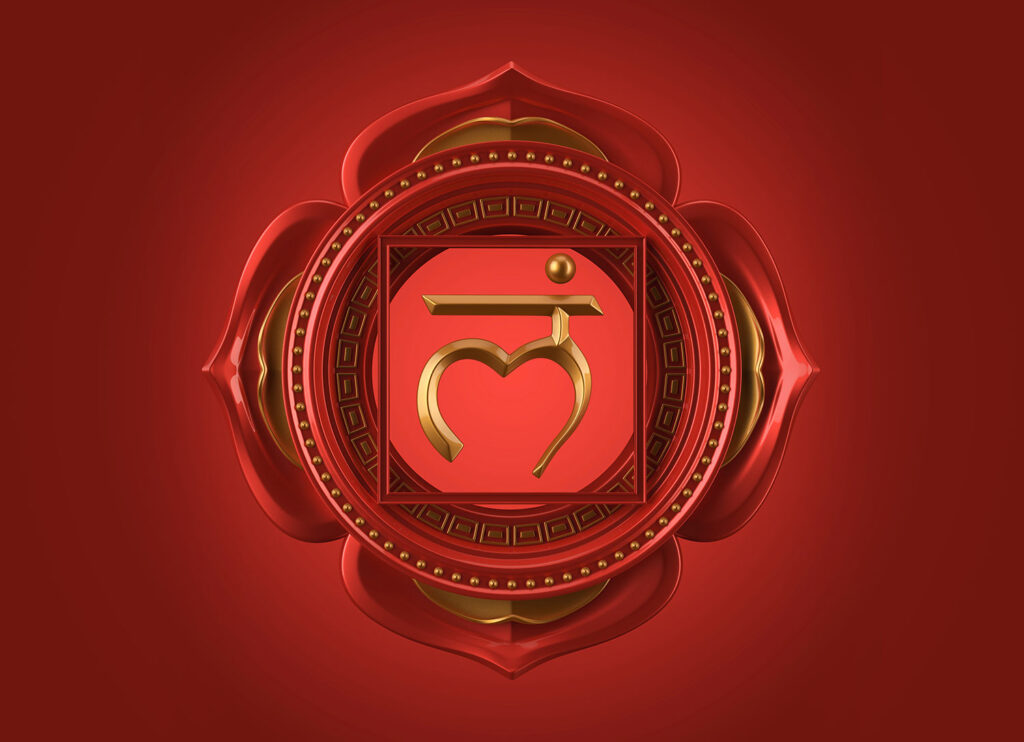
1. Muladhara Chakra: The Root Chakra
- Location: Located at the base of the spine, near the coccyx (tailbone).
- Element: Earth
- Color: Red
- Function: The Muladhara Chakra is the foundation of the entire chakra system. It governs feelings of stability, safety, grounding, and survival. This chakra is responsible for our connection to the physical world, our sense of security, and the energy needed to meet our basic needs.
Key Aspects of the Muladhara Chakra:
- Stability and Grounding: As the root chakra, it anchors us to the earth, providing a stable base for the rest of the chakras. When balanced, it gives us a sense of being grounded, calm, and supported in life.
- Survival and Security: The Muladhara Chakra controls our instincts for survival, safety, and security. It governs our basic needs, such as food, water, shelter, and financial security. It also relates to our ability to provide for ourselves and our loved ones.
- Connection to the Physical Body: This chakra connects us to our physical bodies. It governs our connection to the earth and is associated with our sense of strength, endurance, and vitality.
- Foundation of the Root System: The Muladhara Chakra is often referred to as the “root” of the chakra system because it serves as the foundation upon which the other chakras build. When this chakra is balanced, it supports the healthy flow of energy through all other chakras.
Signs of an Imbalanced Muladhara Chakra:
- Physical Issues: Problems with the lower back, legs, feet, or immune system can indicate an imbalance in the Muladhara Chakra.
- Feelings of Fear and Anxiety: A blocked or unbalanced root chakra can cause feelings of insecurity, anxiety, and fear, particularly around basic needs such as finances and survival.
- Lack of Stability: When this chakra is out of balance, you may feel ungrounded, disconnected, or unstable, unable to find a sense of direction or purpose.
- Financial and Material Instability: Struggles with money, job security, and material possessions may arise when the Muladhara Chakra is imbalanced.
- Restlessness and Inability to Relax: Difficulty relaxing or staying present in the moment may point to a blocked root chakra.
How to Balance the Muladhara Chakra:
- Yoga Poses: Grounding poses like Mountain Pose (Tadasana), Tree Pose (Vrikshasana), and Warrior Poses (Virabhadrasana) help activate the root chakra by connecting you to the earth.
- Affirmations: Use grounding affirmations such as “I am safe,” “I am secure,” “I trust the process of life,” and “I am grounded.”
- Breathing Exercises: Deep, slow breathing can help calm the nervous system and activate the Muladhara Chakra. Alternate nostril breathing (Nadi Shodhana) is particularly helpful in balancing energy in this chakra.
- Walking Barefoot on Earth: Spending time in nature, particularly walking barefoot on grass, dirt, or sand, can help you connect with the earth and activate the Muladhara Chakra.
- Nutrition: Eating grounding foods such as root vegetables (carrots, potatoes, sweet potatoes), protein-rich foods, and foods with earthy flavors can help nourish the Muladhara Chakra.
- Meditation: Focus on the base of your spine while meditating, visualizing the red energy of the Muladhara Chakra glowing bright and strong. Visualize roots growing from the base of your spine, connecting you to the earth.
When the Muladhara Chakra is balanced, you feel secure, stable, and confident in the physical world. You experience a deep sense of inner peace and trust, knowing that your basic needs are met and you are supported by the earth beneath you. This solid foundation allows you to move forward in life with confidence and resilience.
The next chakra after Muladhara (the Root Chakra) is the Svadhisthana Chakra, also known as the Sacral Chakra.
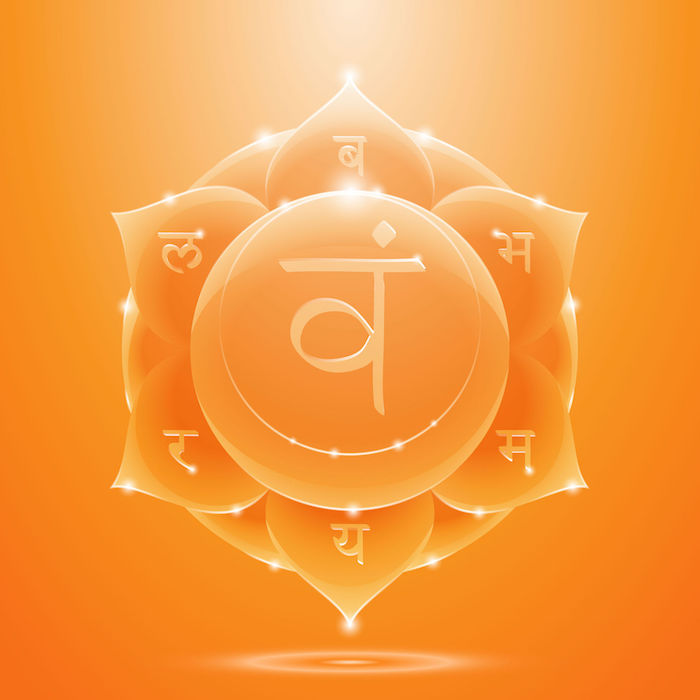
2. Svadhisthana Chakra: The Sacral Chakra
- Location: It is located in the lower abdomen, just below the navel, about two inches below the belly button.
- Element: Water
- Color: Orange
- Function: This chakra governs emotions, creativity, sensuality, pleasure, and relationships. It is associated with the fluidity of life, adaptability, and the ability to experience joy and pleasure.
Key Aspects of the Sacral Chakra:
- Emotional Balance: It plays a major role in your ability to feel and express emotions healthily. An imbalanced Sacral Chakra can lead to emotional instability, fear of intimacy, or difficulty in expressing your emotions.
- Creativity and Passion: The Sacral Chakra is deeply connected to creativity, artistic expression, and your capacity to experience passion in all forms of life—whether that’s in work, relationships, or hobbies.
- Sexuality and Pleasure: This chakra is directly tied to sexuality and the expression of pleasure. A balanced Sacral Chakra allows for a healthy, uninhibited expression of intimacy, while an imbalanced one can lead to issues with sexual health or desires.
- Sense of Fluidity: Since it’s governed by the element of water, the Sacral Chakra is associated with adaptability, flow, and flexibility, both physically and emotionally.
Signs of an Imbalanced Sacral Chakra:
- Emotional instability, mood swings, and difficulty expressing emotions
- A lack of creativity or passion
- Difficulty in relationships or a disconnection from intimacy
- Feeling stuck or unmotivated
- Issues related to reproductive health or sexual dysfunction
How to Balance the Sacral Chakra:
- Yoga poses: Poses that open the hips, such as Pigeon Pose and Cobra Pose, help activate and balance the Sacral Chakra.
- Creative expression: Engage in creative activities like painting, writing, dancing, or any form of artistic expression.
- Affirmations: Use affirmations such as “I am open to experiencing pleasure,” or “I embrace my creativity.”
- Water therapy: Since the Sacral Chakra is associated with the element of water, spending time in or near water (swimming, soaking in a bath) can help balance this energy center.
Once the Muladhara Chakra (Root Chakra) is balanced and stabilized, the Svadhisthana Chakra can be activated to bring more creativity, joy, and emotional fluidity into your life.
The next chakra after Svadhisthana (Sacral Chakra) is the Manipura Chakra, also known as the Solar Plexus Chakra.
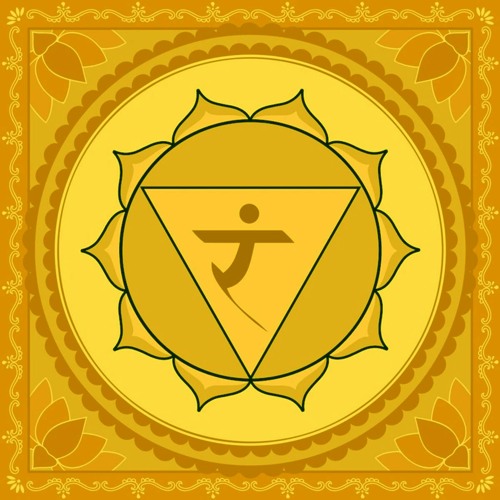
3. Manipura Chakra: The Solar Plexus Chakra
- Location: It is located in the upper abdomen, around the area of the stomach, just above the navel and below the rib cage.
- Element: Fire
- Color: Yellow
- Function: This chakra is associated with personal power, confidence, willpower, and self-esteem. It governs your ability to take control of your life and manifest your desires, as well as your relationship with your inner strength and authority.
Key Aspects of the Solar Plexus Chakra:
- Personal Power & Confidence: This chakra governs your self-worth, confidence, and your ability to assert yourself in the world. When the Solar Plexus Chakra is balanced, you feel empowered, confident, and have a sense of control over your life.
- Willpower & Motivation: It is deeply tied to your ability to make decisions, take action, and follow through with your goals. An activated Manipura Chakra increases your motivation and determination to pursue your passions.
- Self-Esteem: A healthy Solar Plexus Chakra enables a positive self-image, where you accept yourself for who you are, without needing external validation. It’s connected to a strong sense of self and self-respect.
- Digestive System: As the Solar Plexus is located around the stomach area, it also governs digestion. An imbalanced Manipura Chakra can lead to digestive issues such as bloating, ulcers, or a sluggish metabolism.
Signs of an Imbalanced Solar Plexus Chakra:
- Low self-esteem, lack of confidence, or feelings of helplessness
- Difficulty making decisions or taking action
- Overly controlling behavior or, conversely, a lack of motivation and direction
- Digestive issues like indigestion, bloating, or constipation
- Anger, frustration, or excessive stress
- A sense of being disconnected from your true power
How to Balance the Solar Plexus Chakra:
- Yoga poses: Poses that engage the core, such as Boat Pose, Plank Pose, and Warrior III, can help activate and balance the Solar Plexus Chakra.
- Affirmations: Use affirmations like “I am confident and powerful,” or “I trust myself and my decisions.”
- Breathing exercises: Engage in Kapalbhati (breath of fire) or Ujjayi breath to activate the fire element of this chakra.
- Visualization: Visualize a bright, golden-yellow sun in your solar plexus area to energize this chakra and fill you with confidence and strength.
- Healthy Diet: Incorporate foods that are yellow in color, such as bananas, corn, and squash, which are believed to nourish the Solar Plexus Chakra.
When the Manipura Chakra is balanced, it allows you to feel confident, assertive, and ready to take on challenges in your life.
The next chakra after Manipura (Solar Plexus Chakra) is the Anahata Chakra, also known as the Heart Chakra.
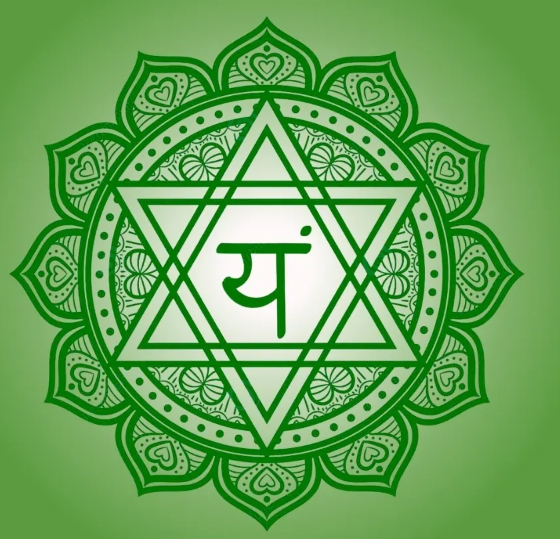
4. Anahata Chakra: The Heart Chakra
- Location: It is located at the center of the chest, around the heart area.
- Element: Air
- Color: Green (sometimes pink)
- Function: The Heart Chakra governs love, compassion, forgiveness, and emotional balance. It is the center of our ability to love ourselves and others unconditionally and fosters harmonious relationships.
Key Aspects of the Heart Chakra:
- Love and Compassion: The Anahata Chakra is the seat of love, kindness, and compassion. When this chakra is open and balanced, you experience love for yourself, for others, and for life itself, without conditions or judgments.
- Emotional Balance: The Heart Chakra helps regulate our emotional experiences. It promotes emotional healing, peace, and the ability to empathize with others. It also allows us to handle and release past emotional wounds or traumas.
- Forgiveness: This chakra is strongly associated with the ability to forgive—both others and ourselves. When balanced, it enables healing from grudges, resentment, or anger.
- Connection to Others: An activated Heart Chakra enhances your ability to connect deeply with others, forming loving and supportive relationships. It also helps in creating a sense of oneness with all living beings and the universe.
Signs of an Imbalanced Heart Chakra:
- Difficulty in giving or receiving love
- Feeling of loneliness, isolation, or disconnection from others
- Emotional wounds or unresolved grief
- A tendency to close oneself off from others, or being overly needy and dependent in relationships
- Lack of empathy or understanding towards others
- Physical issues related to the heart, lungs, or chest area (e.g., asthma, heart conditions)
How to Balance the Heart Chakra:
- Yoga poses: Poses that open the chest, such as Camel Pose, Cobra Pose, and Bridge Pose, are beneficial for balancing the Heart Chakra.
- Affirmations: Use affirmations like “I am worthy of love,” “I give and receive love freely,” or “My heart is open and compassionate.”
- Breathing exercises: Nadi Shodhana (alternate nostril breathing) is a calming pranayama that helps bring balance and emotional clarity to the Heart Chakra.
- Visualization: Imagine a green or pink glowing light filling your chest area, expanding outward with each breath. This light represents unconditional love and compassion.
- Self-Care and Acts of Kindness: Engage in acts of kindness, not only towards others but also towards yourself. Self-love and compassion are key to healing the Heart Chakra.
When the Anahata Chakra is balanced, you feel a deep sense of love, peace, and connection, both within yourself and with others. You are open to giving and receiving love freely, and you experience harmonious relationships with the world around you.
The next chakra after Anahata (Heart Chakra) is the Vishuddha Chakra, also known as the Throat Chakra.
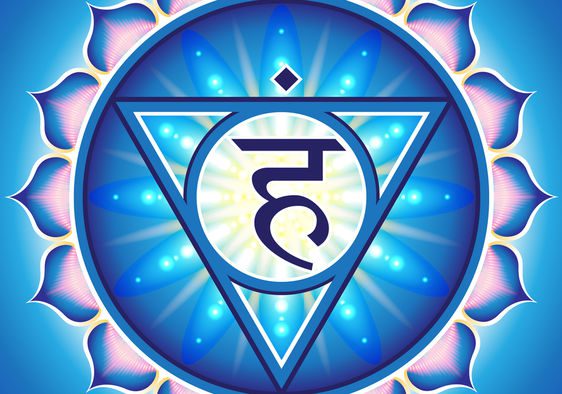
5. Vishuddha Chakra: The Throat Chakra
- Location: Located at the throat area, near the vocal cords.
- Element: Ether (Space)
- Color: Light Blue or Turquoise
- Function: The Throat Chakra governs communication, self-expression, and truth. It is the center of verbal and non-verbal communication, creativity, and the ability to express one’s authentic self.
Key Aspects of the Throat Chakra:
- Communication: The Vishuddha Chakra is directly related to how we express ourselves, both verbally and non-verbally. It governs our ability to speak our truth, communicate effectively, and be understood.
- Authenticity and Self-Expression: It is the center of creative expression. When this chakra is balanced, you can confidently express your ideas, beliefs, and feelings without fear of judgment. It helps you remain true to yourself and your values.
- Listening Skills: A balanced Throat Chakra not only helps in expressing yourself but also in listening to others attentively. It creates a harmonious flow of communication where both speaking and listening are in balance.
- Creativity: This chakra is connected to creative endeavors. It enables the free flow of ideas and creativity, whether it’s through art, writing, music, or any other form of self-expression.
Signs of an Imbalanced Throat Chakra:
- Difficulty in expressing thoughts or feelings
- Fear of speaking or being misunderstood
- Chronic sore throat, neck pain, or other physical issues in the throat area
- Suppressed emotions or lack of self-expression
- Difficulty in listening or feeling disconnected from others’ communication
- Talking excessively or interrupting others without allowing them to express themselves
How to Balance the Throat Chakra:
- Yoga poses: Poses like Fish Pose, Plow Pose, and Shoulder Stand help open and balance the throat area.
- Affirmations: Use affirmations like “I speak my truth,” “My voice is clear and powerful,” and “I am free to express myself creatively.”
- Breathing exercises: Ujjayi Pranayama (victorious breath) is a calming breathing technique that helps balance the Throat Chakra and calm the mind.
- Chanting and Mantras: The Throat Chakra resonates with sound. Chanting mantras or singing can help open this chakra. The sound “HAM” is associated with the Vishuddha Chakra and can be used in chanting or meditation.
- Creative Activities: Engage in creative activities like singing, writing, painting, or any form of self-expression that allows you to freely communicate your thoughts and emotions.
When the Vishuddha Chakra is balanced, you experience clear communication, both with yourself and others. You feel confident in your ability to express your true self, and you also become a better listener, enhancing your relationships and interactions with the world around you.
The next chakra after the Vishuddha (Throat Chakra) is the Ajna chakra, also known as the Third Eye Chakra.
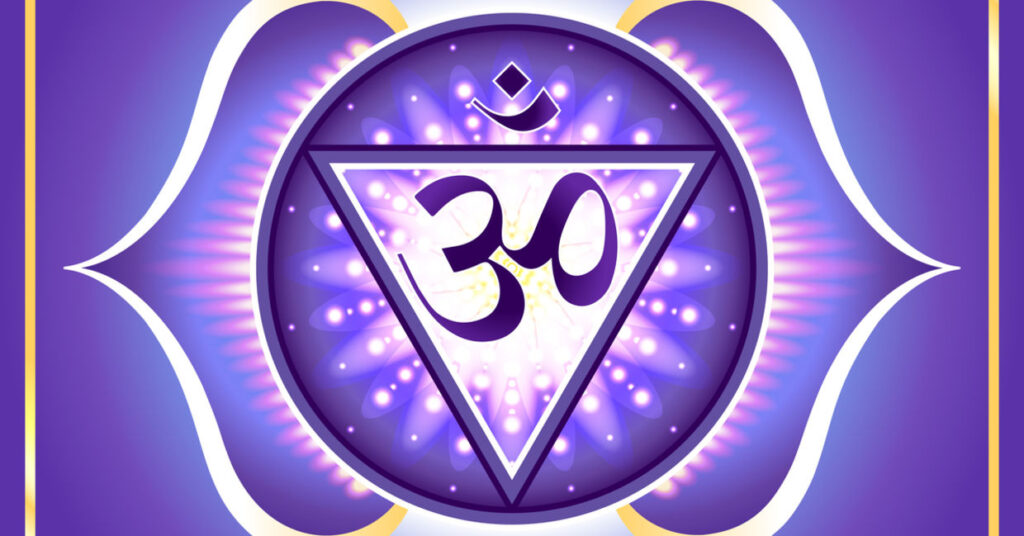
Ajna Chakra: The Third Eye Chakra
- Location: Between the eyebrows, slightly above the bridge of the nose, in the center of the forehead.
- Element: Light
- Color: Indigo or Deep Blue
- Function: The Third Eye Chakra governs intuition, wisdom, perception, and the ability to see beyond the physical realm. It is considered the center of spiritual insight, imagination, and mental clarity.
Key Aspects of the Third Eye Chakra:
- Intuition and Inner Vision: The Ajna Chakra enhances your intuitive abilities, helping you to trust your inner guidance and make decisions based on a deeper sense of knowing. It opens up the ability to see beyond the physical world, tapping into higher consciousness.
- Perception and Insight: This chakra is linked to your ability to perceive the truth. When balanced, it promotes clarity, the ability to see situations from different perspectives, and an understanding of the interconnectedness of life.
- Mental Clarity and Focus: A balanced Third Eye Chakra brings mental sharpness, concentration, and the ability to focus. It enhances memory and intellect, providing a deeper understanding of the world and spiritual matters.
- Awareness of the Subtle Realms: It allows for the experience of altered states of consciousness, facilitating meditative experiences and a deeper connection to the spiritual and unseen dimensions of reality.
Signs of an Imbalanced Third Eye Chakra:
- Lack of Intuition: Difficulty in trusting your instincts or feeling disconnected from your inner wisdom.
- Confusion or Mental Fog: Struggling with concentration, memory, or focus, often feeling mentally scattered or overwhelmed.
- Disconnection from Spirituality: Feeling disconnected from your higher self, struggling to find meaning or purpose in life.
- Headaches or Eye Strain: Physical symptoms like frequent headaches, tension between the eyebrows, or discomfort in the eyes may indicate an imbalance in the Third Eye Chakra.
- Overthinking or Lack of Perspective: An overactive Third Eye may lead to excessive analysis, anxiety, or an inability to see the bigger picture.
How to Balance the Ajna Chakra:
- Yoga Poses: Poses like Child’s Pose, Downward Dog, and Forward Fold help activate and calm the Third Eye area, enhancing clarity and intuition.
- Meditation: Meditation is one of the most effective ways to open the Third Eye. Focusing on the space between the eyebrows or using visualization techniques can stimulate this chakra.
- Affirmations: Use affirmations such as “I trust my intuition,” “I see clearly with my mind and heart,” and “I am connected to my higher self.”
- Breathing Exercises: Pranayama techniques like Nadi Shodhana (alternate nostril breathing) help balance the energy flow in the body, enhancing mental clarity and spiritual insight.
- Essential Oils: Scents like sandalwood, frankincense, and lavender can help open and soothe the Third Eye Chakra, enhancing focus and intuition.
- Visualization: Visualizing indigo light surrounding the forehead or practicing imagery-based meditation can help activate the Third Eye.
When the Ajna Chakra is balanced, you experience increased intuition, clarity of thought, and heightened awareness. You develop a strong connection with your inner wisdom, making it easier to trust your decisions and align with your higher purpose.
The next chakra after Ajna (Third Eye Chakra) is the Sahasrara chakra, also known as the Crown Chakra.
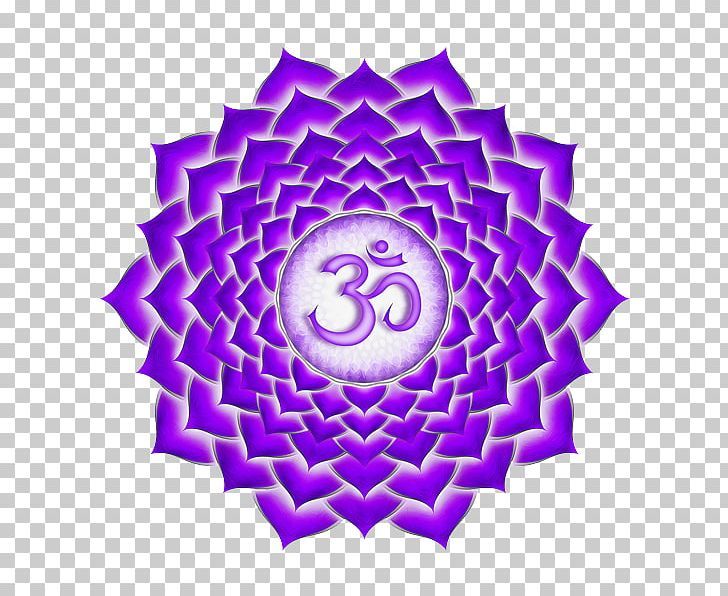
7. Sahasrara Chakra: The Crown Chakra
- Location: At the top of the head, the crown of the skull.
- Element: Thought (or Divine Consciousness)
- Color: Violet or White
- Function: The Crown Chakra is the center of spiritual connection, enlightenment, and higher consciousness. It is associated with the divine, universal energy, and represents our connection to the universe, higher self, and consciousness beyond the physical realm.
Key Aspects of the Crown Chakra:
- Spiritual Connection: The Sahasrara Chakra is the gateway to higher states of consciousness and spiritual enlightenment. It facilitates a deep connection with the divine and the universe, offering a sense of oneness with all that exists.
- Universal Consciousness: It is the center of our awareness of the greater universe and our place within it. It allows us to transcend the ego and realize our connection to the collective consciousness of humanity.
- Inner Peace and Enlightenment: A balanced Crown Chakra leads to a deep sense of inner peace, mental clarity, and spiritual wisdom. It opens the path to enlightenment, where we experience profound joy, liberation, and bliss.
- Connection to Higher Self: The Crown Chakra helps us connect with our higher self or soul’s purpose. It allows for guidance from a place of higher wisdom and fosters a sense of meaning and alignment in life.
Signs of an Imbalanced Crown Chakra:
- Spiritual Disconnect: Feeling disconnected from your spirituality, unable to find meaning or purpose in life, or a sense of existential emptiness.
- Lack of Purpose: Experiencing confusion regarding your life’s purpose or feeling adrift without a clear direction.
- Depression or Anxiety: An unbalanced Crown Chakra may contribute to feelings of depression, anxiety, or a general lack of joy or fulfillment.
- Physical Symptoms: Headaches, dizziness, or issues with the nervous system may manifest as physical symptoms of a blocked or imbalanced Crown Chakra.
- Over-attachment to Material Things: A lack of connection to the higher self may cause an over-focus on material success or external validation, neglecting spiritual growth and personal development.
How to Balance the Sahasrara Chakra:
- Meditation: The most effective way to open and balance the Crown Chakra is through deep meditation. Focus on the top of your head or visualize a violet or white light radiating from the crown.
- Prayer: Engaging in prayer or spiritual practice helps cultivate a sense of connection with the divine, helping open the Crown Chakra.
- Affirmations: Use affirmations like “I am connected to the divine,” “I trust the universe,” and “I am open to spiritual wisdom.”
- Breathing Exercises: Pranayama techniques like Ujjayi breath and deep, conscious breathing help open the Crown Chakra and promote relaxation, enhancing spiritual connection.
- Mindfulness and Presence: Being fully present in the moment and practicing mindfulness helps connect with the higher self, creating space for enlightenment and clarity.
- Spiritual Practices: Engaging in spiritual practices such as chanting, prayer, or spending time in nature can help you connect with universal consciousness and activate the Crown Chakra.
- Essential Oils: Scents like lavender, frankincense, and myrrh are often used to open the Crown Chakra and support spiritual connection.
When the Sahasrara Chakra is balanced, you experience a deep sense of unity, peace, and enlightenment. You feel connected to the universe, your higher self, and the divine, bringing clarity and a profound sense of purpose to your life. It allows you to move through life with a sense of trust, knowing that you are guided by a higher wisdom.
Understanding and balancing your chakras is an empowering journey that connects you with your true self. Each of the 7 chakras plays a vital role in maintaining our physical, emotional, and spiritual health. When these energy centers are aligned and in harmony, we experience greater peace, clarity, and vitality. Whether you’re looking to enhance your creativity, improve your communication, or foster a deeper sense of inner peace, working with your chakras can be a transformative practice. By becoming aware of imbalances and using practices like yoga, meditation, breathwork, and affirmations, you can create a more balanced and vibrant life. Remember, this journey is personal—take your time, listen to your body, and trust in the process.

